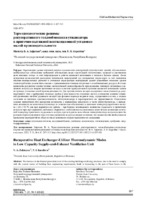| dc.contributor.author | Зафатаев, В. А. | |
| dc.contributor.author | Королёва, Т. И. | |
| dc.coverage.spatial | Минск | ru |
| dc.date.accessioned | 2022-08-08T10:25:54Z | |
| dc.date.available | 2022-08-08T10:25:54Z | |
| dc.date.issued | 2022 | |
| dc.identifier.citation | Зафатаев, В. А. Термодинамические режимы рекуперативного теплообменника-утилизатора в приточно-вытяжной вентиляционной установке малой производительности = Recuperative Heat Exchanger-Utilizer Thermodynamic Modes in Low Capacity Supply-and-Exhaust Ventilation Unit / В. А. Зафатаев, Т. И. Королёва // Наука и техника. – 2022. – № 4. – С. 297-313. | ru |
| dc.identifier.uri | https://rep.bntu.by/handle/data/116963 | |
| dc.description.abstract | Наращивание уровня тепловой защиты ограждающих конструкций существующих зданий, обусловленное необходимостью соблюдения требований действующих норм строительной теплотехники, приводит к увеличению доли тепловых потерь за счет инфильтрации и работы вытяжной вентиляции в тепловом балансе здания. После исчерпания возможностей реализации технических мероприятий для уменьшения энергозатрат за счет изменения объемно-планировочных решений и утепления ограждающих конструкций зданий дальнейшее снижение уровня теплопотребления должно быть связано с применением потенциала вторичных и возобновляемых ресурсов. В статье приведены результаты оценки технико-экономической целесообразности использования теплового потенциала удаляемого воздуха для нагрева приточного воздуха в системе принудительной приточно-вытяжной вентиляции здания на примере установки малой производительности. Для противоточного воздухо-воздушного теплоутилизатора реку-перативного типа с оребрением тепловых трубок в виде множества сплошных листов установлено влияние изменений физических свойств удаляемого воздуха при фазовом переходе водяного пара, содержащегося в нем, в жидкое состояние на тепловую производительность теплоутилизатора и характеристики его эффективности. Определены условия теплообмена (без выпадения конденсата, с выпадением конденсата в части теплоутилизатора, с выпадением конденсата во всем теплоутилизаторе и с опасностью обледенения) в диапазоне температур приточного воздуха (–26)–(+8) ºС для трех вариантов его работы – при балансе номинального количества удаляемого и приточного воздуха и при двух вариантах дисбаланса. Варианты с дисбалансами исследованы в целях поиска возможных сочетаний температур приточного и удаляемого воздуха, при которых во всем объеме теплоутилизатора не происходило бы фазового перехода водяного пара в потоке удаляемого воздуха в жидкое состояние, что исключило бы необходимость проведения мероприятий по сбору и отводу конденсата и предотвращению его замерзания. | ru |
| dc.language.iso | ru | ru |
| dc.publisher | БНТУ | ru |
| dc.title | Термодинамические режимы рекуперативного теплообменника-утилизатора в приточно-вытяжной вентиляционной установке малой производительности | ru |
| dc.title.alternative | Recuperative Heat Exchanger-Utilizer Thermodynamic Modes in Low Capacity Supply-and-Exhaust Ventilation Unit | ru |
| dc.type | Article | ru |
| dc.identifier.doi | 10.21122/2227-1031-2022-21-4-297-313 | |
| local.description.annotation | The increase in the thermal protection level of the existing buildings enclosing structures, due to the need to comply with the current norms of building heat engineering requirements, leads to increasing in the part of heat losses in the thermal balance of a building due to infiltration and exhaust ventilation operation. After exhaustion of the possibilities for the implementation of technical measures to reduce energy costs by changing in volumetric planning solutions and insulating building envelopes further decreasing heat consumption level should be associated with the use of the secondary and renewable resources potential. The paper presents the results of assessing the technical and economic feasibility of using the exhaust air thermal potential for heating the supply air in the forced supply-and-exhaust ventilation system of a building taking as a low-capacity unit as an example. For a counterflow air-to-air recuperative type heat utilizer finned with ribbed heat pipes in the form of a plurality of continuous sheets, the influence of changes in the physical properties of the exhaust air during the phase transition of the water vapor contained in it into a liquid state on the heat exchanger-utilizer performance and characteristics of its efficiency has been established. The conditions of heat exchange are determined (without condensate, with condensate in the part of the heat exchanger-utilizer, with condensate in the entire heat exchanger-utilizer and with the risk of icing) in the supply air temperature range from (–26) to (+8) °C for three variants of its operation with a balance of the nominal amount of exhaust and supply air and with two variants of imbalance. Variants with imbalances have been investigated in order to find possible combinations of supply and exhaust air temperatures, at which there would be no phase transition of water vapor in the exhaust air flow to the liquid state in the entire volume of the heat utilizer, which would eliminate the need for measures to collect and remove condensate and preventing it from freezing. | ru |

